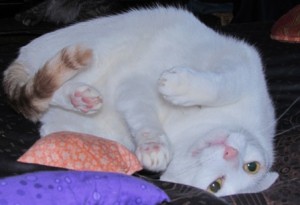Yesterday I didn’t check our mailbox until late afternoon. Then, just as a friend arrived to pick me up, I had a quick look, and boom!!!, there it was: the familiar fat hospital envelope. My January 12 2012 results. Let me tell ya, I almost fainted on the spot. Ignoring all the alarm bells going off in my head (= “noooo, it’s too bloody early! If I’d opted to go to the lab to pick up my results, I’d have waited until February 17! Something’s terrrrribly wrong!”), I ripped it open and glanced at a couple of results. Floods of relief. My m-spike was down, based on what I remembered about my most recent tests (= last June). So was my total IgG. I immediately told my friend who was just as thrilled as I was…
Going down down down! Little dance of joy (for Springsteen fans: http://goo.gl/cYaxh)!
When I got home later in the evening, I checked these results against previous ones. Everything is more or less stable, yahoooooo!, so I’ll just point out a few things that weren’t, mostly in a good sense:
- my blood viscosity is still a bit above normal, but I would like to mention that it is the lowest it’s EVER been (well, slight correction: since 2005, anyway…my earlier, before-2005 tests are in an old file that I haven’t opened in ages): 34 mm/hour. The high end of the normal range is 25; mine has been known to go over 90!
- total protein is down from 9.8 to 9.2, which is still above the reference range but not by much.
- B2M is down from 2.9 to 2.6. Squeals of joy!
- total IgG went from 3930 to 3640. Holy cats. It hasn’t been that low in more than a year. More than a year! MORE THAN A YEAR! Going down down down down…yeah!
- my albumin/globulin ratio is the closest it’s been to the normal range since 2009: 1.06 (= not far from 1.10!).
- monoclonal component: also the lowest it’s been since 2009: 29.7. I mean, it’s UNDER 30. 🙂
- Vitamin D is fine, totally within the normal range.
- No change in my IgA and IgM, which, according to the range, are similar to the IgA and IgM of a 0-1 month old baby…Uhmmmm, no comment!
Let’s see. You might want to know if I was testing anything extra. No, I wasn’t. I was just taking my usual doses of curcumin, fish oil and quercetin. However, I was putting Nigella sativa (black cumin) in our food…I mean, in almost everything I made. (If you want a reminder about Nigella sativa, scroll down my Pages on the right) No idea, though, if that made any difference. But even if it didn’t, we both love this spice’s peppery taste, so I’m going to keep using it…And in my heart, I feel it did make a diff…
So, in conclusion: I’m still stable and going strong…AND tonight it’s supposed to snow in Florence. We should be getting quite a bit of snow, if the forecasts are right.
Yes. Life is good…







